St
John's Hospital
Kingston Lane, Uxbridge, Middlesex UB8
3PL
Medical
dates:
Medical
character:
Isolation. Later, geriatric, long-stay.
The Uxbridge Isolation Hospital
opened in 1894 with 28 beds. Initially there was only a single
ward; any smallpox patients were sent to a temporary hospital built for
such patients in Yeading Lane, Hayes.
In the early 1900s additional ward blocks were built so that patients with diphtheria, scarlet fever or other infectious diseases could be separated from each other.
In 1948 the Hospital joined the NHS under the control of the Uxbridge Group Hospital Management Committee, part of the North West Metropolitan Regional Hospital Board. It had 84 beds and, in 1949, was renamed St John's Hospital (after the parish in which it was located).
The Hospital had six ward blocks. Two of these (one old and one new) each had 11 cubicles, while a large modern block had open wards. Three other small blocks with open wards had been built more than 50 years before. These latter were not in use in 1948, so the oldest was adapted for use as offices for the central administration staff of the Uxbridge Group Hospital Management Committee. Another old ward block later also became offices.
In May 1950 one of the old ward blocks was used to accommodate 24 elderly chronically sick females.
In April 1953 the central administration staff moved to new offices at The Furze on the Hillingdon Hospital site. The two ward blocks which had been used as offices were then improved and became wards for geriatric patients.
In 1955 the Hospital had 93 beds for infectious diseases patients and for the chronically sick.
By 1957 it had 138 beds - 70 for infectious diseases cases and 68 for geriatric patients. A Day Room was provided for the geriatric patients in A Block, and it was hoped eventually to provide a similar facility for the patients in B and C Blocks, in a new building linking them together.
On 2nd May 1960 a new ward for male pre-convalescent patients opened in the former Fever Reserve Ward. The link building with a Day Room for B and C Blocks was built at a cost of £10,000. It also contained Physiotherapy and Occupational Therapy Departments. The three geriatric wards were improved, with bedhead lights installed in the wards. A telephone switchboard was installed with extensions to various wards.
In 1962 the old Nurses' Home was improved to provide accommodation for nursing staff at Hillingdon Hospital.
In 1968 the Hospital had 140 beds for infectious diseases and geriatric patients.
In 1974, following a major reorganisation of the NHS, the Hospital came under the control of the Hillingdon District Health Authority, part of the North West Thames Regional Health Authority. It became a long-stay hospital with 90 beds. The site also housed the headquarters for the District Health Authority.
In 1978 a question was asked in Parliament about the meagre food supplies offered to the long-term geratric patients at the Hospital, amounting to £0.78 spent on each patient daily.
The Hospital closed in 1986.
In the early 1900s additional ward blocks were built so that patients with diphtheria, scarlet fever or other infectious diseases could be separated from each other.
In 1948 the Hospital joined the NHS under the control of the Uxbridge Group Hospital Management Committee, part of the North West Metropolitan Regional Hospital Board. It had 84 beds and, in 1949, was renamed St John's Hospital (after the parish in which it was located).
The Hospital had six ward blocks. Two of these (one old and one new) each had 11 cubicles, while a large modern block had open wards. Three other small blocks with open wards had been built more than 50 years before. These latter were not in use in 1948, so the oldest was adapted for use as offices for the central administration staff of the Uxbridge Group Hospital Management Committee. Another old ward block later also became offices.
In May 1950 one of the old ward blocks was used to accommodate 24 elderly chronically sick females.
In April 1953 the central administration staff moved to new offices at The Furze on the Hillingdon Hospital site. The two ward blocks which had been used as offices were then improved and became wards for geriatric patients.
In 1955 the Hospital had 93 beds for infectious diseases patients and for the chronically sick.
By 1957 it had 138 beds - 70 for infectious diseases cases and 68 for geriatric patients. A Day Room was provided for the geriatric patients in A Block, and it was hoped eventually to provide a similar facility for the patients in B and C Blocks, in a new building linking them together.
On 2nd May 1960 a new ward for male pre-convalescent patients opened in the former Fever Reserve Ward. The link building with a Day Room for B and C Blocks was built at a cost of £10,000. It also contained Physiotherapy and Occupational Therapy Departments. The three geriatric wards were improved, with bedhead lights installed in the wards. A telephone switchboard was installed with extensions to various wards.
In 1962 the old Nurses' Home was improved to provide accommodation for nursing staff at Hillingdon Hospital.
In 1968 the Hospital had 140 beds for infectious diseases and geriatric patients.
In 1974, following a major reorganisation of the NHS, the Hospital came under the control of the Hillingdon District Health Authority, part of the North West Thames Regional Health Authority. It became a long-stay hospital with 90 beds. The site also housed the headquarters for the District Health Authority.
In 1978 a question was asked in Parliament about the meagre food supplies offered to the long-term geratric patients at the Hospital, amounting to £0.78 spent on each patient daily.
The Hospital closed in 1986.
Present status (October 2008)
The buildings have been demolished. The site has been redeveloped and now contains Ivybridge Close, built by Berkeley Homes in 1991.
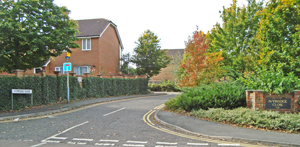
The entrance to Ivybridge Close from Kingston Road. The ivy-covered wall on the left may be part of the former Hospital's boundary.
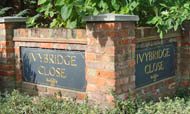
Entry signage to the new development, perhaps on the former Hospital gateway.
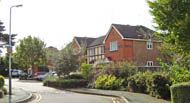
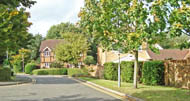
New housing in Ivybridge Close.
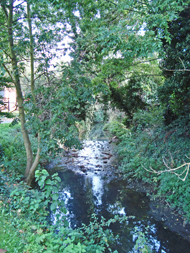
The River Pinn runs behind the Hospital site.
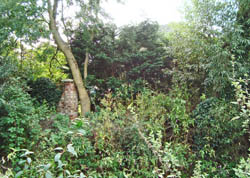
The back of the Close, as seen from across the stream. Part of an old wall can just be discerned, perhaps also marking the Hospital boundary.
Wingfield H 2003 The workhouse and hospital at Hillingdon (Middlesex) 1744-1967. London, Hillingdon Hospital NHS Trust.
http://hansard.millbanksystems.com
www.british-history.ac.uk
www.ruislip.co.uk
Return to home page